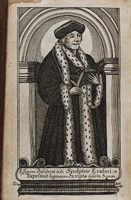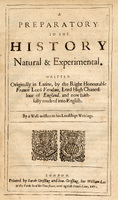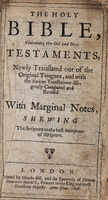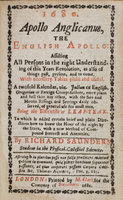-

Erasmus's Colloquiorum was a standard scholarly text, reprinted many times. This edition contains a life and portrait of the author. Elizabeth Flesher (fl. 1670-1688) was the widow of James Flesher, and the daughter of Cornelius Bee (fl. 1636-71), a prominent bookseller. Her late husband, James (fl. 1652-67) was at one time proceeded against for illegally printing law books. James' father was Miles Flesher (fl. 1611-1664), a wealthy and prominent master printer, from whom he inherited the business.
-

Gertrude Dawson (fl. 1649-61) succeeded her late husband, John (fl. 1634-48). The Dawsons had inherited their printing house from John's father, also named John (d. 1634). The Dawsons were interested in fine printing: John Jr. owned among his ornaments a variation on an Aldine device; Gertrude had a new font of roman type cut for herself after taking over the business. This printing is a second impression.
-

This popular "how-to" text on animal husbandry and other household uses was sold by Hannah Sawbridge (fl. 1682-86), the widow of George Sawbridge the elder (fl. 1647-81). Sawbridge was a partner in the King's Printing House, treasurer of the Company of Stationers for much of his life, and Master of the Company in 1675. He left behind a good deal of wealth to his wife, and was known as one of the greatest booksellers in England at the time. Hannah continued the (quite lucrative) printing business until his son took over.
-

The Griffins were a printing family, part of a house originally founded in 1590. Sarah (fl 1653-73) succeeded her husband Edward II (fl 1638-52). Edward II had printed in partnership with his mother, Anne (fl 1634-43), and later succeeded her His father, Edward I (fl 1613-1621) was also a printer. Bennet Griffin is probably Sarah's son, who later restricted himself to bookselling and publication, rather than being physically involved with the printing of works like Bacon's Sylva Sylvarum.
-

Joan Orwin married three different printers in her life: John Kingston (1553-84), George Robinson (1585-7), and Thomas Orwin (1587-93). She continued the business from 1593 to 1597, when it was taken over by her son, Felix Kingston. The text is one of the standard histories of the period. Thomas Orwin's device, used by his widow, is visible on the title page, with the motto "By Wisdom peace by peace plenty." The book was likely sold by Joan Broome (fl. 1591-1601), widow of William Broome (1577-91); this is an early example of women working together in the printing trades.
-

The executrix of Thomas Newcombe (fl. 1649-81) was his widow, Ruth (fl 1643-65, 1691-1700?) Newcombe was her second husband; she had also been widowed by another printer, John Raworth (fl. 1638-45). She continued the business from 1646 to around 1649, when she married Thomas Newcombe, who took over. In a 1668 survey, Newcombe's printing house was one of the largest in London. Newcombe was also a shareholder in the King's Printers. This closely printed Bible, produced after his death, was apparently a collaboration between the widow and Charles Bill (fl. 1687-1699), another of the King's Printers. According to Henry Plomer, Bill, although a shareholder in the King's Printers, never appeared to actually exercise the printing trade--which would mean that the production of the book was likely entirely directed by Ruth Newcombe.
-

This almanac may have been "jobbed out" by the Company of Stationers to Mary Clark (fl. 1677-96), the widow of Andrew Clark (fl. 1670-78). Mary continued the business for nearly twenty years after her husband's death, and was quite prolific, printing almanacs, devotional literature, and the like, often for the Company of Stationers.
-

This book is one of the earliest in the collection printed by a woman. Elizabeth Redman, originally Pickering, was the widow of Robert Redman (fl. 1523-1540). She only printed a few works before remarrying, but is of note because she is one of the earliest documented widow printers in Great Britain. Robert Redman was a successor of Richard Pynson, (fl. 1492-1530); they were rivals while Pynson was alive, since Redman not only issued pirated editions of Pynson's works, but adopted his "sign" (i.e. address) as well.







